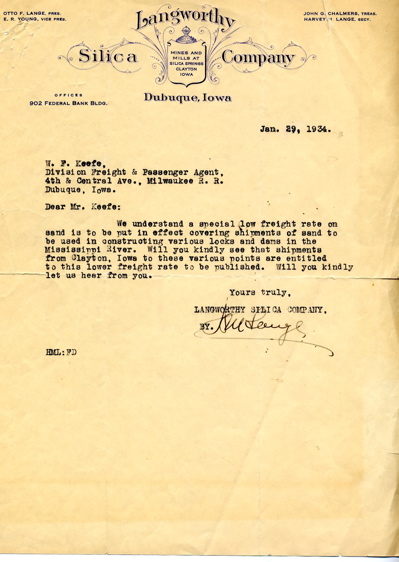Encyclopedia Dubuque
"Encyclopedia Dubuque is the online authority for all things Dubuque, written by the people who know the city best.”
Marshall Cohen—researcher and producer, CNN
Affiliated with the Local History Network of the State Historical Society of Iowa, and the Iowa Museum Association.
LANGWORTHY SILICA COMPANY
LANGWORTHY SILICA COMPANY. Since 1878, there have been three separate silica sand mine operations in the Clayton area.
The first, an open pit quarry started by William Buhlman in 1878, changed hands several times before closing in the 1930s. The second, under the management of Richard Kolch, made brick and tile from the silica sand at Clayton from 1919 to 1929. The present mine operation was started by John Langworthy in 1916 and was leased by the Martin-Marietta Corporation in 1959. In 1983, Pattison Bros. purchased the mine from the Langworthy-Chalmers family and started to store fertilizer and other bulk commodities in the vast underground acreage of the existing mine.
The mine has fourteen miles of tunnels and currently provides, in total capacity, 60 acres of underground storage area. The mine runs horizontally into the river bluffs for 2,300 feet and also runs parallel to the river for 3,200 feet. It is approximately 250 feet from the surface in some areas.
During the early 1960s, people throughout the United States were intensely concerned about the possibility of a nuclear attack. The federal government responded by designating certain areas as civil defense shelters. The Clayton Mine was selected as a shelter site and 10 railroad cars and 10 semitrailers of food stuffs were placed in the mine, along with medical supplies, in the event of an attack.
The mine has a capacity for 44,000 persons. The story is told that since there was only one road to the mine, people were to drive to the mine, park their car, and enter the mine. The next person would push the first car into the river and park in its place. The civil defense director for Clayton County admitted that he did not know how that many people would ever get to the mine.
---
Source:
Brad and Diane Chalmers. email-May 22, 2013


